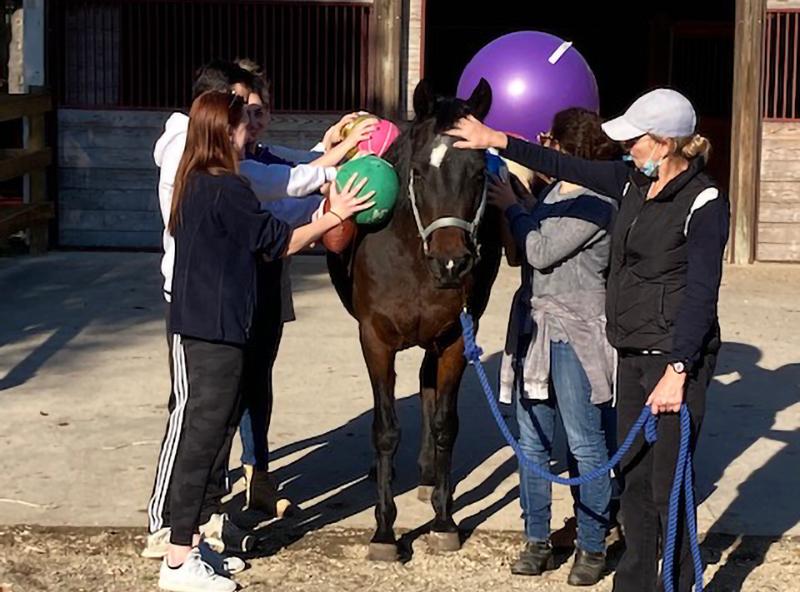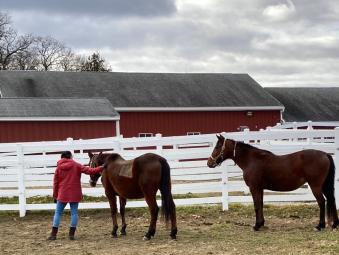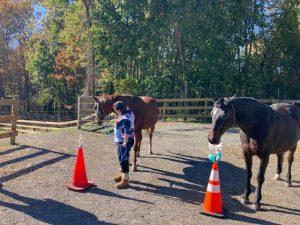-
About
- Leadership & Faculty
- News & Events
-
Academics
- Graduate
- Advanced Clinical Training
- Continuing Education
-
Student Life
-
Research
-
Hospitals & Clinics
- Emergency Care
- Hospital Services
-
Community Outreach
- Volunteer
Equine-Assisted Learning Course Sets Students Up for Success
In Cummings School’s Paddock to Practice course, horses teach students what they can’t learn in the classroom

Veterinarians dedicate themselves to keeping their animal patients healthy and pet owners happy. Sometimes, unfortunately, this dedication means they forget to care for themselves. As numerous surveys have shown, the unique pressures involved in being a veterinary student or a practicing veterinarian can take a significant toll on emotional and mental well-being. This, in turn, can negatively impact how effectively students and doctors communicate with professors, clients, and colleagues.
That’s where the Paddock to Practice (PtP) course comes in. The course was established at Cummings School in 2019 and is available every semester as a selective to first- and second-year veterinary students. The class usually has around eight to 10 students, some of whom have horse experience and some who don’t. What PtP offers is that which can’t be taught in a classroom. Instead of medical knowledge, PtP teaches students self-awareness and professionalism skills.
The course is run by eight faculty members—four humans, and four equines. “We consider the horses part of the faculty because they contribute to teaching the students,” says Angie Warner, D.V.M., associate professor in the Department of Comparative Pathobiology and one of the course’s facilitators.
As prey animals, horses are highly sensitive to their surroundings. By interacting with these animals in a variety of situations, the students learn the subtleties of non-verbal communication, the art of teamwork, and how to reduce their own stress levels. “We aim to create resilient and self-aware veterinarians and ones that can speak up for what they need in a team environment,” says Dr. Warner.
The course is separated into three segments. The first focuses on building relationships and trust, both student-to-student and horse-to-student. The second involves team-building exercises and doctor-client interactions. Finally, the students work on integrating what they’ve learned as they look towards their fourth year in school and working in a clinical setting.
Each class begins with a “breathing circle,” in which students stand in a circle in the paddock and focus on their breathing, with the goal of centering themselves and reducing any stress they are carrying with them. The horses are at liberty, meaning they're just wandering around the paddock among the students and faculty.
“Horses are very attuned to breathing and heart rate,” explains clinical social worker Eric Richman, MSW, LICSW. If they detect rapid heart rates and rapid breathing in us, that's going to put them more on alert. If they detect calm breathing and lower heart rates, they're calmer and more comfortable. They tend to keep their distance at first. At some point they literally become part of the breathing circle.”
As the semester progresses, students work on bedside manner and learn to address the challenges of cooperating with others to achieve goals.
“As veterinarians, we have all this medical knowledge that we want to share, and there's a tendency for a new veterinarian to just start telling a client, ‘This is what your pet has,’” says Virginia Rentko, VMD, clinical associate professor. “The client can be overwhelmed. They might just want to know if their dog is going to be able to sit on the couch with them. This is where they build self-awareness of how to approach someone and learn what the other person's needs are.”
Exercises in which the students approach and interact with the horses can translate into how they behave with future clients.
“Horses will be incredibly honest,” says Beth Timlage, client services manager. “If you approach them in a way they see as aggressive, or if they're afraid or your approach is too quick, they will let you know. They will run away or act assertively, or they won't cooperate. So we work on grounding ourselves and being very aware of how we're being with the other. And in this case with horses, the other definitely tells you how you're being, where people do not.”
Eden Hurlburt (V22) stresses how learning the Four Core communication skills—open-ended questions, reflective listening, empathy, and body language—has been invaluable as she continues her education.
Hurlburt gives an example of one PtP exercise that focused on the importance of knowing how to read body language.
“We spent a lot of time learning the horses' body language and observing how they responded to different stimuli,” she says. “We focused on our own body language too. Are we portraying calm confidence or nervousness? In one exercise, we lead the horses through an obstacle course with "scary" stimuli they hadn't seen before, like a stuffed Halloween spider. We used our mindfulness and body language skills to lead them confidently through these obstacles and learned to change our approach when they showed they were uncomfortable.”
Hurlburt says these types of exercises coupled with faculty-led debriefing sessions have given her a communication toolbox that she now relies on in all situations.
“I've aimed to use Four Core in every client interaction in my clinical rotations,” she says. “Paddock to Practice shaped my experience as a D.V.M. student.”
Department:
DVM Program

